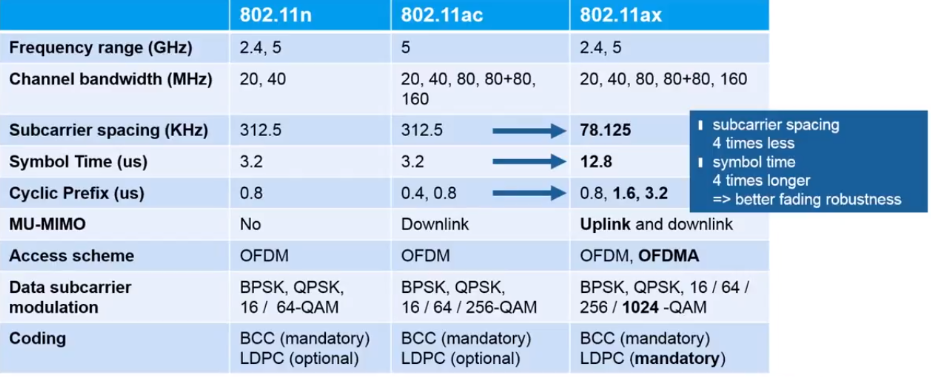The primary objective of 802.11ax AKA Wi-Fi 6 is to make sure that Wi-Fi devices use RF spectrum more efficiently.
RF spectrum is a very precious resource and we need to make sure that it gets used effectively and efficiently.
802.11 ax is also called as high-efficiency Wi-Fi standard. This is a big paradigm shift as compared to its legacy 802.11 standards 802.11 a/b/g/n/ac. In legacy standards, the primary objective was to achieve higher and higher throughput or how to send or receive data quickly in a single user connection scenario where the environment is near to ideal.
802.11 ax is the first standard with real-life use conditions explicitly. 802.11ax goes back to dual-band physical layer so like 802.11 n which support both bands 2.4Ghz and 5Ghz. It is important because 802.11ac is 5Ghz only and now 802.11ax is pushing into both sides.
Few major new capabilities:
- 11ax support 2.4Ghz as well 5Ghz
- OFDMA- Orthogonal Frequency multiplexing access
- Resource units as small as 26 subcarriers
- BSS colouring
- Target wake time (TWT)
The major update or change in WiFi6 is OFDMA, As we all aware that we were using OFDM concept since 802.11a. So taking from that concept instead of using all frequency bandwidth for one frame or one communication why we don’t use what we need. On this concept frequency band is divided into subcarriers or sub channelization which will allow multiple different transitions to go out at the same time. So instead of having 20Mhz or 40Mhz for one transmission, we can have such as a 2Mhz channel or 8Mhz channel etc.
Resource units are mentioned above is actually breaking down the channel into smaller chunks as small as 26 subcarriers. Logic is to break down the channel to different resource units and then allocate these resource units to devices and transmit to these devices concurrently.
BSS coloring is nothing to do with actual colour but to add a tag in the frame which is just saying colour or number of each the BSS. 802.11ax radios are able to differentiate between BSSs using a BSS color identifier when other radios transmit on the same channel. If the colour is the same, this is considered to be an intra-BSS frame transmission. In other words, the transmitting radio belongs to the same BSS as the receiver. If the detected frame has a different BSS colour from its own, then the STA considers that frame as an inter-BSS frame from an overlapping BSS.
Target wake time feature in 802.11ax will help devices to go to sleep more efficiently than legacy standard. The access point can help the devices by monitoring the traffic pattern of the devices and can tell these battery operated devices exact time to wake up for transmission purpose. So basically device does not need to wake up more frequently to check if there is some data buffered for it. Most importantly access point makes sure that particular time access medium is clear for this device and it does not need to contend for the medium.
Comparison of legacy WLAN and WLAN 802.11ax physical layer aspects:

Pingback:Wireless broadband alliance conference - WiFi
Great job site admin! You have made it look so easy talking about that topic, providing your readers some vital information. I would love to see more helpful articles like this, so please keep posting! I also have great posts about Airport Transfer, check out my weblog at QN9
Pingback:Wireless broadband alliance conference – Media Sat UK